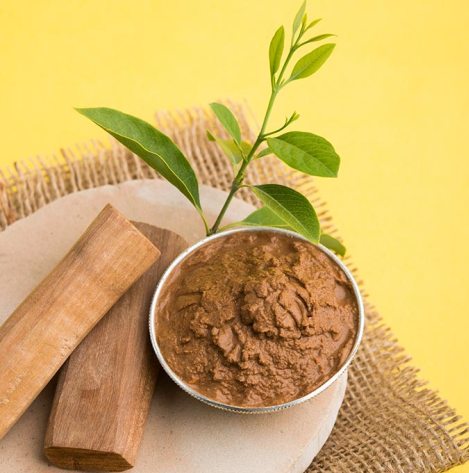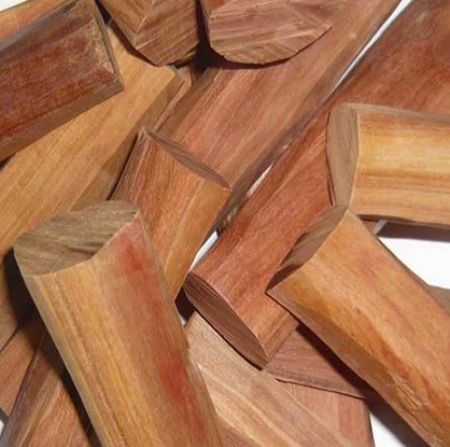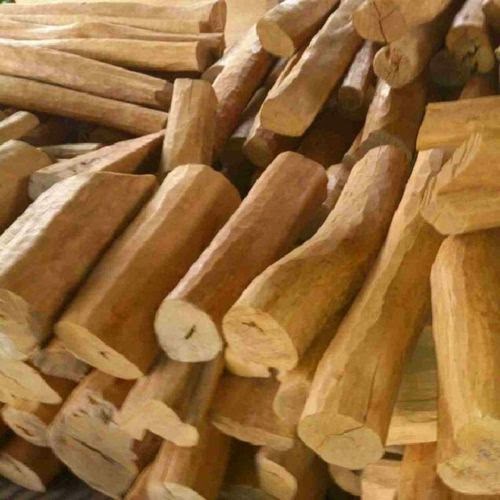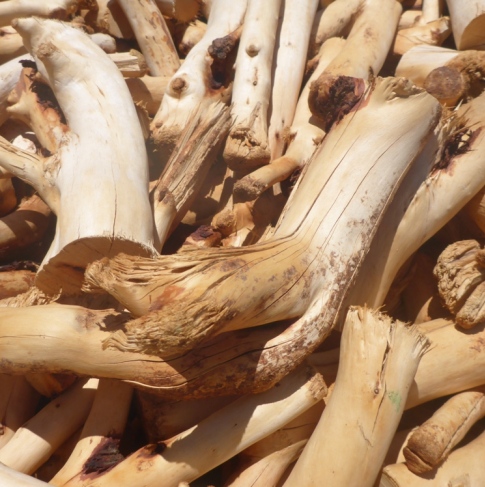.png)
.png)




Botanical name Santalum Album
Family Santalaceae
Source Wood
Origin India
Processing Method Steam Distillation
Color/Consistency A medium, clear, pale yellow to golden liquid.
Aroma A base note with a medium aroma, Sandalwood is oriental and balsamic with a soft, sweet, rich, woody aroma.
Blends With Bergamot, Black Pepper, Geranium, Lavender, Myrrh, Rose, Vetiver and Ylang-Ylang.
Product Abstract
Sandalwood is a valuable tree associated with Indian culture. It is the second most expensive wood in the world. The heartwood of the tree is treasured for its aroma and is one of the finest natural materials for carving. Sandalwood oil is used in perfumes, cosmetics, aromatherapy and pharmaceuticals. As the tree grows, the essential oil develops in the roots and heartwood, which requires at least 15 to 20 years. Full maturity is reached after 60 to 80 years. The core of dark heartwood gradually develops, which is covered by outer sapwood. The sandalwood tree is never felled, but uprooted in the rainy season, when the roots are richer in the precious essential oil. Vietnam and New Caledonia have well controlled plantations of genuine Sandalwood.
History
One of the oldest incense materials, Sandalwood has been in use for at least 4,000 years. It is one of the most calming incenses and therefore is one of the preferred ones for meditation. It calms the mind, enhances mental clarity, and aids in the opening of the Third Eye. The aroma increases devotion and combined properly can help transmute sexual energy for those who are practicing celibacy. Many ancient Temples and accessories such as rosaries and staffs are made from this wood.
Harvesting/Extraction Information
Sandalwood companies use steam distillation in order to extract sandalwood oil. Steam distillation is a process in which steam heated at extremely high temperatures is passed through the powdered wood. The steam releases the sandalwood essential oil that is locked within the cellular structure of the wood. The mixture of steam and oil then flows through a condenser and cools, yielding a layer of oil and a layer of water. The sandalwood essential oil separates from the hydrosol rises to the top so it can then be collected. The distillation process for sandalwood oil takes anywhere from 14 to 36 hours, longer than for many other essential oils. Despite the fact that this method requires a longer process than other distillation methods, it’s known to produce superior quality oil, yielding 84.32% santalol
Common Usage
Caution
No risks have been associated with sandalwood essential oil, except that it is recommended not to be used raw on the skin. For application on the skin, it should be mixed with some type of carrier oil.
Key constituents
(Z)-a-Santalol 46.2–59.9%
(Z)-b-Santalol 20.5–29.0%
(Z)-Nuciferol 1.1–5.5%
epi-b-Santalol 4.1–4.3%
(Z)-a-trans-Bergamotol <3.9%
a-Santalal 0.5–2.9%
b-Santalal 0.6–1.9%
(Z)-Lanceol 1.5–1.7%
(E)-b-Santalol 1.5–1.6%
b-Santalene 0.6–1.4%
Spirosantalol <1.2%
a-Santalene 0.8–1.1%
Quality East Indian sandalwood oil may be adulterated by the addition of sandalwood terpenes and fragrance chemicals. Other known adulterants include Australian sandalwood oil, East African sandalwood oil, Indian bastard sandal oil amyris oil, bleached copaiba balsam, and non-odorous materials such as polyethylene glycol, castor oil, coconut oil and DEHP.
Safety summary
Hazards A rare but known cause of adverse skin reactions.
Contraindications None known.
Maximum dermal use level 2%
Our safety advice
Froma total of 3,542 dermatitis patients, only 12 reacted to patch testing with 2% sandalwood oil. Based on this information, and because of the risk of photoallergic reactions, especially in Japanese people, we recommend a maximum use level of 2%.
Organ-specific effects
Adverse skin reactions In a modified Draize procedure on guinea pigs, sandalwood oil was non- sensitizing when used at 5% in the challenge phase. Undiluted East Indian sandalwood oil was irritating to rabbits, was slightly irritating to mice, but produced no irritation in 18 volunteers. Tested at 10% on 25 volunteers it was not sensitizing. East Indian sandalwood oil, tested at 10% in consecutive dermatitis patients, induced allergic responses in 15 of 1,606, and five of 318. Similarly tested at 2%, there were reactions in none of 387, one of 1,200, seven of 1,606, and four of 318. In a prospective study of adverse skin reactions to cosmetic ingredients identified by patch test East Indian sandalwood oil elicited contact dermatitis in two of 487 cosmetic-related cases. Of 281,100 dermatitis patients, 13,216 had contact dermatitis, and of these 713 were related to cosmetic ingredients. Of this last group, three reacted to East Indian sandalwood oil. Of 167 fragrance-sensitive dermatitis patients, 11 were allergic to 10% East Indian sandalwood oil on patch testing. From 1990 to 1998 the average patch test positivity rate to 2% sandalwood oil in a total of 1,483 Japanese eczema patients suspected of cosmetic sensitivity was 0.8%. In a multicenter study, Germany’s IVDK reported that 49 of 3,671 consecutive dermatitis patients and 18 of 1,002 patients suspected of fragrance allergy tested positive to 10% East Indian sandalwood oil. In Japan, East Indian sandalwood oil is regarded as a high-risk skin sensitizer and potential cause of pigmented contact dermatitis. A case of photoallergy to sandalwood oil was reported by Starke and subsequently, photoallergic reactions to 2% sandalwood oil were seen in three of 138 patients who were photopatch tested in the USA. Sandalwood oil is not phototoxic.
Hepatotoxicity Oral administration of sandalwood oil to male rats significantly reduced carbon tetrachloride-induced liver damage.
Systemic effects
Acute toxicity East Indian sandalwood oil acute oral LD50 in rats 5.58 g/kg; acute dermal LD50 in rabbits >5 g/kg.
Antioxidant/pro-oxidant activity Sandalwood oil showed moderate activity as a DPPH radical scavenger and low activity in the aldehyde/carboxylic acid assay.
Carcinogenic/anticarcinogenic potential Sandalwood oil was not genotoxic in the B. subtilis rec-assay, with or without S9 activation. East Indian sandalwood oil decreased DMBA-induced and TPA-promoted skin papillomas in mice, reducing papilloma incidence by 67% and multiplicity by 96%. At the same time it reduced TPA-inducedODC activity by 70%. These findings suggest that East Indian sandalwood oil could be an effective chemopreventive agent in skin cancer. The enhancement by East Indian sandalwood oil of glutathione S-transferase activity and acid-soluble sulfydryl levels are suggestive of a chemopreventive action. The oil contains no known carcinogens.
Comments
The ISO standard for East Indian sandalwood oil of >90% santalols may require re-evaluation. Specifications of >43% of (Z)-a-santalol, and >18% (Z)-b-santalol were suggested by Howes et al. In 1988 an East Indian sandalwood oil produced in 1987 was compared with one produced in 1905. This comparison shows, along with other changes, increases in a- and b-santalal and a- and b-santalene, and decreases in (Z)-a-santalol and (Z)- b-santalol in the aged oil. In a report on trees, UNEP-WCMC proposed that CITES add Santalum album to its list of threatened plant species. Some 1,700 hectares of Santalum album trees are now being cultivated inWestern Australia, for future production of sandalwood oil.